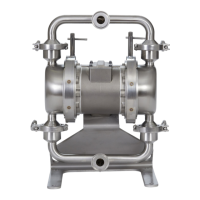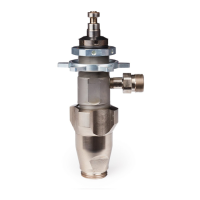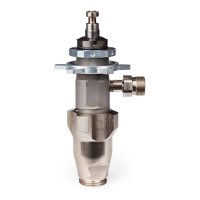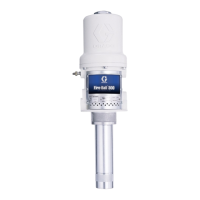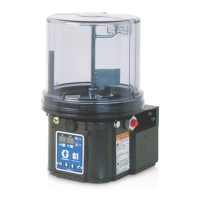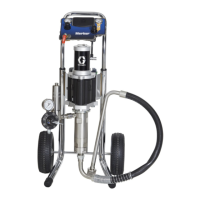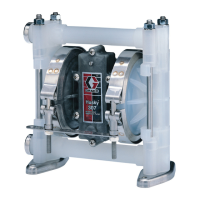WA
RNlNG
FOR
PR.OFESSlONAL
USE
ONLY. OBSERVE ALL
WARNINGS.
Read
and
understand
all
instruction
manuals
before
operating
equipm,ent.
General
Safety
System
Pressure
Any misuse of the equipment or accessories, such as over-
This pump develops
8
bar
/720
psi/ MAXIMUM
WORKING
pressurizing, modifying parts, using incompatible chemicals
PRESSUREat
8
bar 1120 psi) incoming air pressure. NEVER
and fluids. or usina worn or damaaed Darts. can cause them to exceed
8
bar (120 osil air suoolv
to
the
oumo.
DO
NOT
exceed
rupture and result-in serious bodily injury, including eye injury:
the maximum working pressure of any component or ac-
fire, explosion or property damage. cessory used
in
the system.
~ ~ ~~
.
~
~~__~,
.~
~~~,~~
~~~.
”.
could cause it to malfunction.
NEVER alter or modify any part of this equipment; doing
so
Fluid Compatibility
BE SURE that all fluids and solvents are chemically compatible
CHECK
all
equipment regularly and repair or replace worn or
with the wetted parts shown in the Technical Data on the back
cover. Always read the fluid and solvent manufacturer’s
damaged parts immediately. literature before using them in this pump.
Take precautions to avoid a toxic fluid spill. See
TOXIC
FLUID
HAZARD,
below.
Improper handling of toxic fluids or inhaling toxic vapors can
cause extremely serious bodily injury, even death, due to
2.
Be
sure to pipe and dispose of the exhaust air safely. If the
diaphragm fails, the fluid will be exhausted along with the
splashing in the eyes, ingestion, or bodily contamination.
Know what fluid you’are pumping and its specific hazards.
air.
Store toxic fluid in an appropriate, approved container.
Disoose of
it
accordina to
all
Local. State. and Federal
3.
Be sure to secure the fluid outlet hose tightly into the
receivina container to orevent
it
from comina loose and im-
guidelines for toxic mateGals. Be sure tOobseN8
a11
thefollow- properlfdraining the hid.
ing precautions when handling known or potentially toxic
fluids.
sucrloN
HAZARD
”
1. Always wear appropriate clothing and equipment, such as
eye protection and breathing apparatus, to protect
NEVER place your hands on or near the pump suction inlet.
yourself.
Powerful suction could cause serious bodily injury.
FIRE
OR
EXPLOSION
HAZARD
~~~~~~~~~~~
Static electricity is created by the high velocity flow of fluid
through the pump and hose. If every part
of
the equipment is
not properly grounded, sparking may occur, and the system
solvents and the fluid being pumped, dust particles and other
may become hazardous. Sparks can ignite fumes from
flammable substances, and can cause a fire or explosion and
serious bodily injury and property damage.
Grounding
To reduce the risk
of
static sparking, ground the pump and all
your local electrical code for detailed grounding instructions
other equipment used or located in the pumping area. CHECK
forvourareaandtvoeofeouioment.BESUREtoaroundallof
..
this’equipment:
..
1.
Pump:
by connecting a ground wire and clamp as shown in
Fig
1.
2. Air and
fluid
hoses: use only grounded hoses with a max-
imum of 150 m 1500 feetl combined hose length to ensure
grounding continuity.
3.
Air compressor: according to the manufacturer’s recom-
mendations.
4.
All solvent pails used when flushing, according to local
code.
Use
only metalpails, which are conductive. Do not
place the pail on a non-conductive surface, such as paper
or cardboard, which interrupts the grounding continuity.
and washer
(X).
Insert one end of
a
1.5 mm 112 ga) minimum
TO
ground the
pump,
‘loosen the groundin lug locknut
IWI
ground wire IYI into
the slot in the lug
(2)
and tighten the
locknut securely. See Fig 1. Connect the clamp end of the
on page 11 to order
a
ground wire and clamp.
ground wire to a true earth ground. Refer to ACCESSORIES
Y
I
w
Fig
1
United States Government safety standards have been adopted under the Occupational Safety and Health Act. These
standards-particularly the General Standards, Part 1910, and the Construction Standards, Part 1926-should be
~~ ~
mnr..*.rrl

